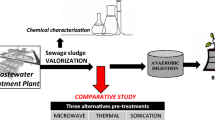Abstract
Excess sludge treatment and disposal is currently a challenge in wastewater treatment plant due to socio-economic and environmental regulation factors. Therefore, it is necessary to explore and develop technology for reduction of excess sludge in wastewater treatment plants rather than treating the generated sludge. This paper discusses technologies for excess sludge growth reduction using high pressure homogenizer treatment which causes cell lysis. The cell lysis and the microbial cellular maintenance energy requirement increases as a result of applied stress. This causes the energy required for non-growth reactions to increase with simultaneous increase in substrate conversion into carbon dioxide rather than microbial cell multiplication.














Similar content being viewed by others
References
Abbassi B, Dullstein S, Rabiger N (2000) Minimization of excess sludge production by increase of oxygen concentration in activated sludge flocs; experimental and theoretical approach. Wat Res 34(1):139–146
ALPHA, AWWA (1999) Standard methods for the examination of waste and wastewater, WEF, 20th edn. American Water Works Association, Denver
Baier URS, Schmidheiny P (1997) Enhanced anaerobic degradation of mechanically disintegrated sludge. Wat Sci Tech 36(11):137–143
Barjenbruch M, Kopplow O (2003) Enzymatic, mechanical and thermal pre-treatment of surplus sludge. Adv Environ Res 7:715–720
Bougrier C, Delegenes JP, Carrere H (2007) Impacts of thermal pretreatment on the semi-continuous anaerobic digestion of waste activated sludge. Biochem Engng J 34:20–27
Dewil R, Appels L, Baeyens J, Degreve J (2007) Peroxidation enhances the biogas production in the anaerobic digestion of biosolids. J Hazard Mater 146:577–581
DIN 38414 S6 (1986) Bestimmung der Sauerstoffverbrauchsrate, Deutsches Institut fur Nornung e.V. (Germany)
Ginestet P (2000) Method for assessing process efficiency. Centre International de Recherche Sur I’ Eau et I’Environnement (CIRSEE), Suez-Lyonnaise des Eaux: Le PecQ Surseine, France: 2-25, Unpublished internal report
Henze M, Grady CPL, Jr. Gujer W, Marais GvR, Matsuo T (1987) Activated sludge model No. 1. IAWPRC scientific and technical report no. 1, IAWPRC, London
Henze M, Gujer W, Mino T, Matsuo T, Wentzel MC, Marais GVR (1995) Activated sludge model no. 2. IAWQ scientific and technical report no. 3, IWAQ, London
Hope J (1986) Sewage sludge disposal and utilization study. Washington State Institute for public policy
http://themes.eea.europa.eu/Environmental_issues/waste/indicators/sewage/w5_sludge.pdf (last seen 4th November 2008)
Kampas P, Parsons SA, Pearce P, Ledoux S, Vale P, Churchley J, Cartmell E (2007) Mechanical sludge disintegration for the production of carbon source for biological nutrient removal. Wat Res 41:1734–1742
Karahan-Gull O, Artan N, Orhon D, Henze M, van Loosdrecht MCM (2002) Respirometric assessment of storage field for different substrates. Wat Sci Technol 46(1/2):345–352
Kopp J, Mueller J, Dichtl N, Schwedes J (1997) Anaerobic digestion and dewatering characteristics of mechanically disintegrated excess sludge. Wat Sci Tech 36(11):129–136
Krist Gernaey A, Petersen B, Ottoy J-P, Vanrolleghem P (2001) Activated sludge monitoring with combined respirometric—titrimetric measurements. Wat Res 35(5):1280–1294
Low E, Chase HA (1999a) Reducing production of excess biomass during wastewater treatment. Wat Res 33(5):1119–1132
Low EW, Chase HA (1999b) The effect of maintenance energy requirements on biomass production during wastewater treatment. Wat Res 33(3):847–853
Marjoleine PJ, Weemaes, Willy H Verstraete (1998) Evaluation of current wet sludge disintegration techniques. Chem Technol Biotechnol 73:83–92
Mathieu S, Etienne P (2000) Estimation of wastewater biodegradable COD fractions by combining respirometric experiments in various So/Xo ratios. Wat Res 34(4):1233–1246
Mueller J, Lehne G, Schwedes J, Battenburg S, Naveke R, Kopp J, Dichtl N, Scheminski A, Krull R, Hempel DC (1998) Disintegration of sewage sludge and influence of anaerobic digestion. Wat Sci Tech 38(8/9):425–433
Munnich K, Mahler CF, Fricke K (2006) Pilot project of mechanical- biological treatment of waste in Brazil. Waste Manag 26:150–157
Orhon D, Okutman D (2003) Respirometric assessment of residual organic matter for domestic sewage. Enzym Microbe Tech 32:560–566
Save SS, Pandit AB, Joshi JB (1997) Use of hydrodynamic cavitation for large scale microbial cell disruption. Trans I Chem E 75:41–49
Sikkim J, Park CW, Kim TH, Lee M, Kim S, Kim SW, Lee JW (2003) Effects of various pretreatment for enhanced anaerobic digestion with waste activated sludge. J Biosci Bioengng 95(3):271–273
Spanjers H, Vanrolleghem P (1995) Respirometry as a tool for rapid characterization of wastewater and activated sludge. Wat Sci Tech 31(2):105–114
Tremier A, De Guardic A, Massiani C, Paul E, Martel JC (2005) A respirometric method for characterizing the organic composition and biodegradation kinetics and the temperature influence on the biodegradation kinetics for a mixture of sludge and bulking agent to be co-composted. Bio Resour Tech 96:169–180
Vollertsen J, Hvitved-Jacobsen T (1998) Aerobial microbial transformations of resuspended sediments in combined sewers—a conceptual model. Wat Sci Tech 37(1):69–76
Waste treatment and disposal (2005) 2nd edn, Wiley, England
Wei Y, Van Houten RT, Borger AR, Eikelboom DH, Fan Y (2003) Minimization of excess sludge production for biological wastewater treatment. Wat Res 37:4453–4467
Young DK, Richardson MD (1998) Effects of waste disposal on benthic faunal succession on the abyssal seafloor. J Marine Syst 14:319–336
Acknowledgments
The author wish to thank Dr.-Ing. Johannes Mueller for his help and suggestions during this work. Thanks are due to Dr. A.B. Mandal, Director, CLRI for permission to publish this work, Head, Chemical Engineering Division and Dr. M. Surianarayanan for their useful discussions.
Author information
Authors and Affiliations
Corresponding author
Rights and permissions
About this article
Cite this article
Rai, C.L., Rao, P.G. Influence of sludge disintegration by high pressure homogenizer on microbial growth in sewage sludge: an approach for excess sludge reduction. Clean Techn Environ Policy 11, 437–446 (2009). https://doi.org/10.1007/s10098-009-0202-y
Received:
Accepted:
Published:
Issue Date:
DOI: https://doi.org/10.1007/s10098-009-0202-y




